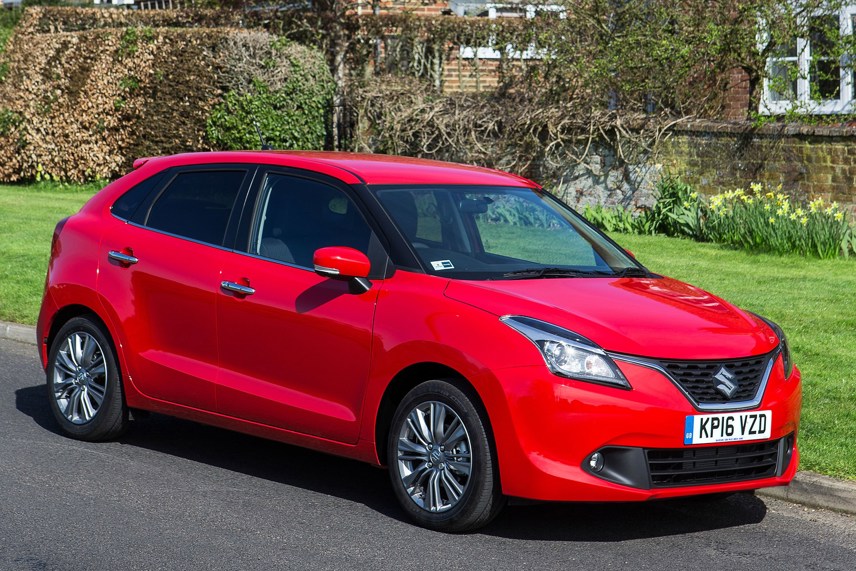Review
Suzuki has had phenomenal success in the UK with its Swift supermini over the past 12 years, with annual sales volumes passing 10,000 units.
However, the Japanese brand recognises that some previous owners have outgrown the diminutive runabout as they’ve started a family, leading to them abandoning the brand in their search for more space and practicality.
To address this, Suzuki introduced the Baleno into UK showrooms last month. At 3.99 metres long, it’s a larger car than the Swift, which measures 3.85m bumper to bumper. It’s cleverer inside too, as Suzuki claims it offers 30cm more interior space than the Swift. In its class, the Indian-built Baleno offers the best tandem distance – the measurement between the front and rear seats. On the media drive, Baleno indeed felt spacious for a supermini-class car and will provide competition for the similarly spacious Hyundai i20, Honda Jazz and Vauxhall Corsa.
Suzuki GB’s sales and marketing director Dale Wyatt said it offers a more rational choice for buyers looking for extra interior space and larger boot capacity who may not be looking to move up significantly in size and price to a Vitara or S-Cross.
“I’m really proud of Baleno, it gives us an opportunity to target a new customer base,” he said. Launch marketing is including TV and billboards, and Wyatt has a “conservative expectation” to sell 3,500 units in its first year.
Product manager Ed Norman added: “We have a good conquest opportunity with this car, for downsizers and people who used to own Swift, but have left the brand. This gives us an opportunity to talk to those people again and try to win them back into the brand.”
Baleno is host to several firsts for Suzuki. One is a 1.0-litre Boosterjet turbocharged three-cylinder petrol engine, which produces the sort of power seen last decade in a 1.8-litre unit. Another is the addition to its 1.2-litre Dualjet petrol unit of a mild hybrid system, branded SHVS. It incorporates an integrated starter generator, which acts as both a starter motor and generator. It also generates electricity through regenerative braking, which it stores in a compact lithium-ion battery placed under the front passenger seat.
This is used to assist the engine during moving off and acceleration, and also when under stop-start conditions. The SHVS system only uses its conventional engine starter motor when first started from cold. Under all other conditions, it uses the higher-voltage ISG unit to allow smooth and quiet engine restarts.
The result is CO2 emissions as low as 94g/km, so the buyer will pay nothing for VED initially. However, changes to the VED system from April 2017 mean customers buying from then will save little road tax compared with the sportier Boosterjet. The SHVS requires a service less frequently – every 12,500 miles compared with every 9,000 miles for the Boosterjet – nevertheless, Suzuki expects 85-90% of Baleno sales to be Boosterjet models.
Standard equipment for all Baleno models is comprehensive. The £12,999 entry model from launch, badged SZ-T, (available with 1.0-litre Boosterjet only), includes six airbags, alloy wheels, air conditioning, and cruise control with speed limiter. It also has a standard infotainment system with satellite navigation, DAB radio with USB and Bluetooth connectivity, plus functions to use certain smartphone apps through MirrorLink and Apple CarPlay.
The top-grade model, badged SZ5, is available with either engine and gains automatic climate control, rear electric windows, a 4.2-inch colour trip display, LED rear lights and adaptive cruise control. It also has a Radar Brake Support system, which alerts the driver if a collision is likely and can apply the brakes automatically if it becomes inevitable.
For customers with a lazy left arm, a six-speed automatic transmission is available as an option with Boosterjet SZ5 trim, which also includes a hill-hold function and paddle shifters behind the steering wheel in case the driver wishes to change gear manually.
The new Baleno is available from launch with an incentivised PCP finance plan at 5.9% APR. Taking the SZ-T model as an example, the offer comprises of zero customer deposit, £1,000 deposit contribution from Suzuki followed by 48 monthly payments of £199. Payments can also be reduced to just £159 over the same period if a deposit of £1,679 is made.
“We’re aware that, for a B-segment car, £13,000 is not the cheapest price, but the equipment is far superior to any other,” said Norman.
An award-winning journalist and editor, with two decades of experience covering the motor retail industry, and accredited by the Institute of Leadership and Management (ILM) plus the National Council for the Training of Journalist (NCTJ)
As editor of AM since 2016, Tim is responsible for its media content, planning and production across AM's multiple channels, including the website, digital reports, webinars, social media and the editorial content of AM's events, Automotive Management Live and the AM Awards. His focus is on interviewing senior leaders of franchised dealer groups and motor manufacturer national sales companies to examine latest developments in UK motor retail.



Factsheet
Price £12,999-£15,349
Engine 1.0-litre Boosterjet: 110bhp; 1.2-litre SHVS: 89bhp
Performance 0-62mph 11-12.3secs, top speed 111-124mph
Transmission 5sp man, 6sp auto
Efficiency 57.6-70.6mpg, 94-115gkm CO2
RV 3yr/30k 37%
Rivals Honda Jazz, Hyundai i20, Škoda Fabia














